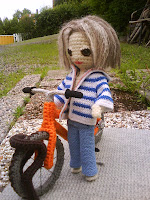Hanne-Marit is a child of nature. She loves to go for long hikes in the mountain and in the forest. She is also one of the few females I know who likes to go hunting. The theme for her Mini-Me thus had to be "A rest while waiting for the moose".
 When Hanne-Marit is hiking in the mountains, she wears a white and red flannel shirt which, according to herself, smell of bonfire. I haven't seen (or smelled) this shirt, but I tried to crochet it anyway. It didn't really look like a flannel shirt, but I thought it mad a nice jacket. I also gave her some grene hunting trousers as well.
When Hanne-Marit is hiking in the mountains, she wears a white and red flannel shirt which, according to herself, smell of bonfire. I haven't seen (or smelled) this shirt, but I tried to crochet it anyway. It didn't really look like a flannel shirt, but I thought it mad a nice jacket. I also gave her some grene hunting trousers as well.  Mini-Hanne-Marit is like the other Mini-Mes a modification of Beth Webber's doll "Mini Free Spirit". You can find patterns for this and many other beautiful dolls, with clothing and more, on her blog "By hock by hand". The hair is made by Tyn alpakka from Du store alpakka and Plumet from Sesia. Her eyes are from Sunchatcher Eyes, and the doll herself is crocheted in an acrylic yarn I found on Craft designs 4 you called Red Heart Super Saver. Her clothing is crocheted from leftovers.
Mini-Hanne-Marit is like the other Mini-Mes a modification of Beth Webber's doll "Mini Free Spirit". You can find patterns for this and many other beautiful dolls, with clothing and more, on her blog "By hock by hand". The hair is made by Tyn alpakka from Du store alpakka and Plumet from Sesia. Her eyes are from Sunchatcher Eyes, and the doll herself is crocheted in an acrylic yarn I found on Craft designs 4 you called Red Heart Super Saver. Her clothing is crocheted from leftovers. The tree stump and the grounds are crocheted by a yarn Rosendahl. You can find the pattern for the stump and mushrooms on Beth Webber's blog "By hock by hand". The moss on the ground is crocheted using a stitch called "the ripple stitch". See this you-tube clip to see how it is done. The mountain cranberries are done by making small French knots in the moss. You can find instructions on this blog.
The tree stump and the grounds are crocheted by a yarn Rosendahl. You can find the pattern for the stump and mushrooms on Beth Webber's blog "By hock by hand". The moss on the ground is crocheted using a stitch called "the ripple stitch". See this you-tube clip to see how it is done. The mountain cranberries are done by making small French knots in the moss. You can find instructions on this blog.


































